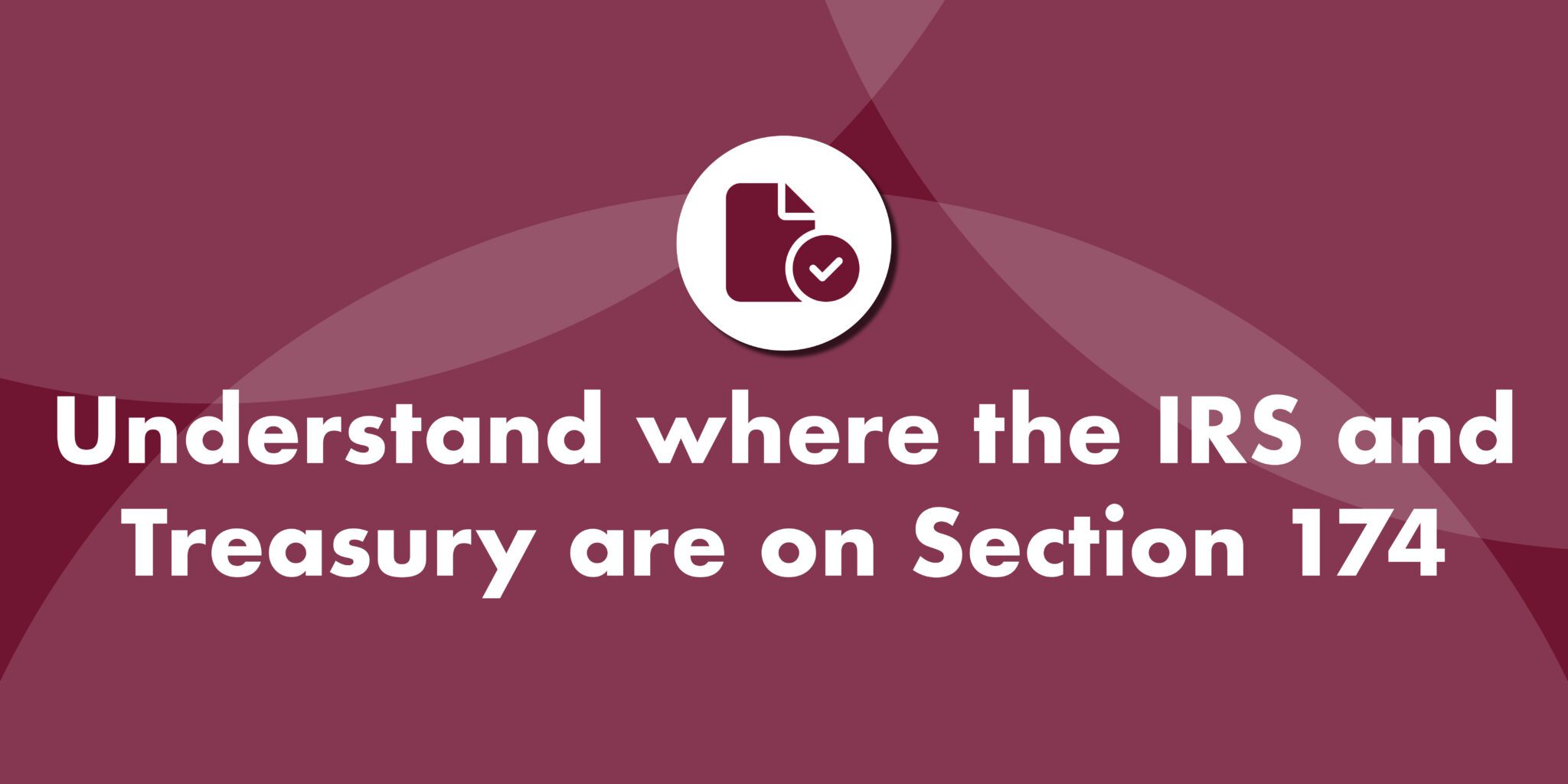
Interim Guidance on Section 174
By: Paige Riordon
The Tax Cuts and Jobs Act (“TCJA”) amended IRC Section 174 requiring the capitalization and amortization of specified research or experimental (“SRE”) expenditures for tax years beginning after December 31, 2021. Prior to TCJA, signed into law Dec. 22, 2017, taxpayers could elect to deduct SRE expenditures in the year incurred or capitalize and amortize for a period not less than 60 months. As most taxpayers elected the first option and deducted SRE expenditures during the current tax year, taxpayers generally did not specifically identify SRE expenditures because they were treated the same as Section 162 Ordinary & Necessary expenses.
On September 8, 2023, Treasury and the IRS issued Notice 2023-64 (the “Notice”) to provide interim guidance for applying the amended Section 174 rules. The Notice addressed the following areas of Section 174.
Capitalization and amortization of SRE expenditures under Section 174
Taxpayers are required to capitalize and amortize SRE expenditures “ratably over the applicable Section 174 amortization period, beginning with the midpoint of the taxable year in which such expenditures are paid,” Notice 2023-63. Section 174 expenditures attributable to US-based research are amortized over 5 years (60 months) and Section 174 expenditures attributable to foreign-based research are amortized over 15 years (180 months). This section of the Notice also provides further clarity around identification of the midpoint of a taxable year for determining the allowable amount of amortization for the first taxable year.
Scope of Section 174
Section 174 defines SRE activities as the development of any computer software or research or experimental activities described in Treas. Reg. Section 1.174-2, those incurred in connection with the taxpayer’s trade or business, which represent costs incident to research and development activities performed in the experimental or laboratory sense.
The Notice provides the following non-exhaustive list of costs that are considered incident to SRE activities: labor costs, materials and supplies, cost recovery allowances, costs of obtaining a patent, operations and management cost, and travel costs for the performance of SRE activities or the direct support of SRE activities.
The Notice also highlights costs that are not treated as SRE expenditures, such as costs paid or incurred by general and administrative service departments that only indirectly support or benefit SRE activities, interest on debt to finance SRE activities, costs listed in Treas. Reg. Section 1.174-2(a)(6)(i)(vii) (efficiency surveys, management studies, consumer surveys, advertising or promotions, etc.), and amounts representing amortization of SRE expenditures.
SRE expenditures must be allocated to SRE activities based on a cause-and-effect relationship allocating costs to SRE activities benefiting from the costs. The Notice recognizes that different allocation methods may be warranted for different expense types (i.e., labor, supplies, cost recovery allowances); however, taxpayers must use a consistent methodology within a specific type of costs (wages, payroll taxes, etc.).
Software Development
The Notice defines computer software as well as upgrades and enhancements made to computer software. Specifically, computer software is defined as “any computer program or routine that is designed to cause a computer to perform a desired function or set of functions…,” Notice 2023-63. Upgrades and enhancements to computer software is defined as modifications that result in additional functionality or materially increase in speed or efficiency of the software.
The Notice provides a non-exhaustive list of SRE activities that are considered software development including planning, designing, developing, building and testing the computer software, as well as writing source code and converting it to machine-readable code.
Research Performed Under Contract
The Notice provides clarity around the appropriate taxpayer to recognize costs associated with SRE activities performed under contract. Research providers (party that performs the SRE activities) should recognize costs as SRE expenditures if the provider has rights to the product OR is at risk for the SRE expenditures. Research recipients (party that receives the services or purchases the product) will only recognize SRE expenditures if the recipient has both rights to the research AND is at risk for the SRE expenditures.
Disposition, Retirement, or Abandonment of Property
The Notice notes Treasury and the IRS intent to provide clarity in determining the treatment of unamortized SRE expenditures upon the disposition, retirement, or abandonment of the related property. In general, Section 174 prohibits taxpayers from recognizing unamortized SRE expenditures upon the disposition, retirement, or abandonment of property; rather, taxpayers will continue to amortize SRE expenditures over the remaining Section 174 amortization period. However, the Notice does provide two exceptions where unamortized SRE expenditures can be recovered early.
Treatment of SRE expenditures under Section 460
Treasury and the IRS recognize the current mismatch of income and expenses under the current Section 460 regulations. Currently, taxpayers are required to include SRE expenditures incurred during the taxable year in the numerator of the taxpayer’s percentage completion ratio. The Notice proposes updates to Section 460 that would require only the current year SRE amortization expense to be included in the numerator of the percentage completion ratio.
Application of Section 482 to cost sharing arrangements involving SRE expenditures
Treasury and the IRS have also noted their goal to revise Section 482 to ensure that each controlled participant share of intangible development costs are in proportion to its share of reasonably anticipated benefit from the research and development efforts. The Notice proposes that cost sharing transaction payments will first offset cost, and the remainder will then be treated as income.
Effective Date
The Notice is effective for tax years beginning after September 8, 2023; however, taxpayers may follow for tax years beginning after December 31, 2021, if all sections of the Notice are followed. Treasury and the IRS noted their intentions to provide procedural guidance providing taxpayers automatic consent to adopt accounting methods provided in the Notice.
Treasury is requesting comments on the Notice by November 24, 2023.
How does Section 174 impact the R&D tax credit?
Qualified research expenses (wages, supplies, cost of computers, and contract research) are a subset of SRE expenditures. In order for expenditures to be eligible for the R&D tax credit, they must be classified as SRE expenditures under Section 174. In other words, SRE expenditures will include qualified research expenses as well as other indirect cost such as cost recovery allowances, facility cost, and travel expenses.
To learn more about R&D tax credits, including Section 174 changes, contact Paige Riordon, Principal, R&D Tax Credit Leader.

Paige Riordon CPA, Principal, R&D Tax Credit Leader
Paige serves as BRC’s Research Credit Leader out of the Greensboro, NC office. Paige has almost 20 years of experience assisting clients with Research Credits across a variety of industries, including consumer products, life sciences, manufacturing, pharma, software, and technology. Paige uses her experiences to customize studies to fit each client’s unique needs while […]
The information contained in this article is for informative purposes only and should not be relied on when making any business, legal, or other decisions. This information may be updated without notice and/or may not contain the most current information that is available related to this topic. Please consult with your advisor to determine how this information applies to your specific facts and circumstances.

